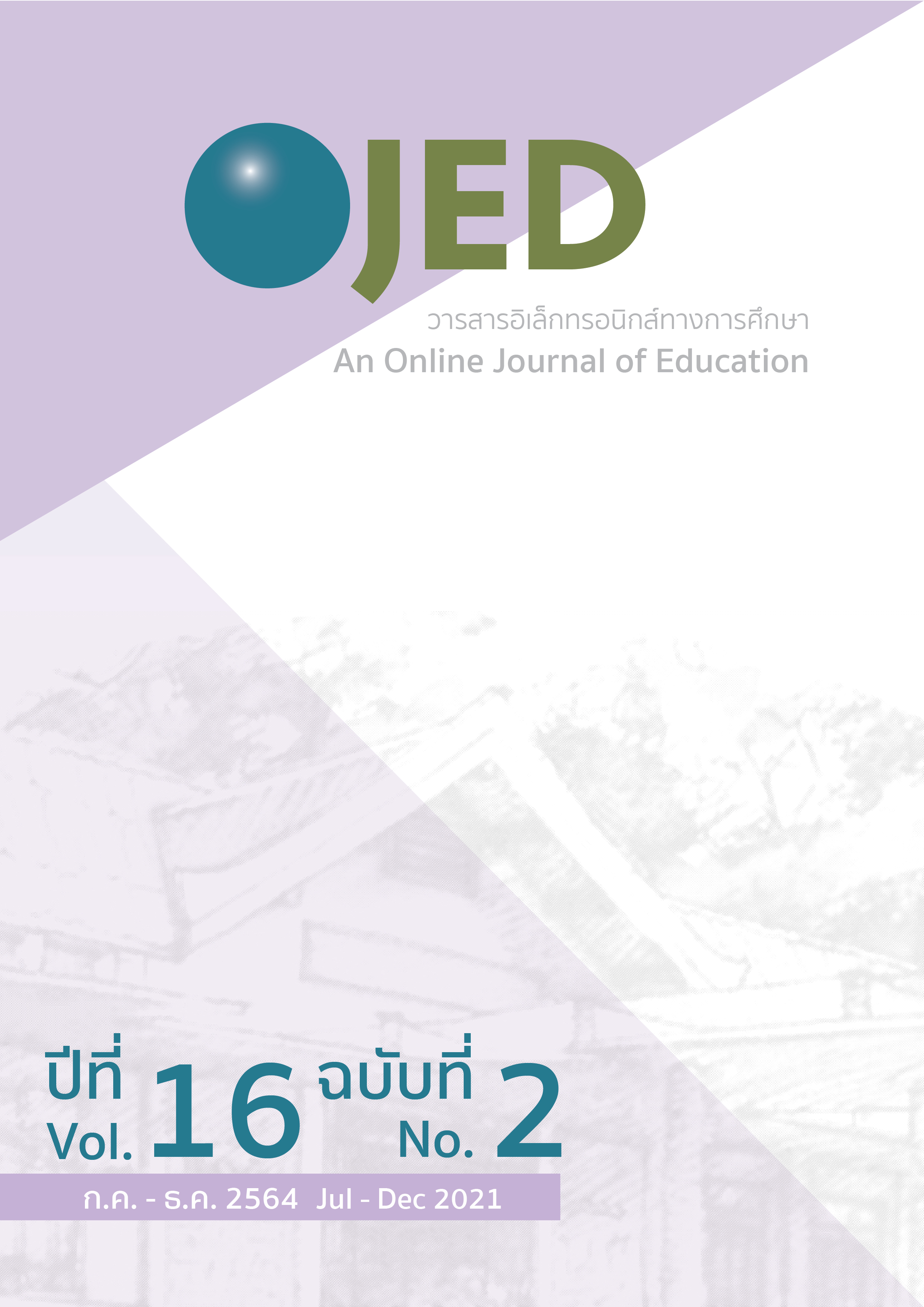Parents’ Opinions on the Desirable Characteristics for Preschoolers in the English Program of the Anubanwatpichaisongkram School
DOI:
https://doi.org/10.14456/ojed.2021.55Keywords:
parent’s opinions, desirable characteristics, preschoolersAbstract
The purpose of this research was to study parents’ opinions on the desirable characteristics for preschoolers in the English Program in 4 aspects. The populations were 50 preschool parents studying in the English Program of the Anubanwatpichaisongkram School. The research instruments were a questionnaire form and an interview form. The data were analyzed using frequency distribution, percentage, means, standard deviation, and content analysis. The research results found that the overall of parents’ opinions on the desirable characteristics was at the high level (M = 4.30). Each aspect was described: 1) emotional and social aspect (M = 4.38): being proud on their own success was the highest mean (M = 4.90); andwilling to follow regulations was the lowest mean (M =4.04). 2) physicalaspect (M = 4.33):being able to dress up on their own was the highest mean (M = 4.50); andbeing able to tie theirown shoes was the lowest mean (M = 4.18). 3) Intelligenceaspect (M = 4.26): giving a basic explanation of things was the highest mean (M = 4.64); interesting in reading words/symbols found in daily life was the lowest mean (M = 3.66). 4) language aspect (M = 4.21): willing to join with cultural experienceswas the highest mean (M = 4.62); and responding a simple question in English was the lowest mean (M = 3.86).
References
กัลยา วานิชย์บัญชา. (2542). การวิเคราะห์สถิติ : สถิติเพื่อการตัดสินใจ (พิมพ์ครั้งที่ 4). จุฬาลงกรณ์วิทยาลัย.
ชูศรี ตันพงศ์. (2546). การประเมินพัฒนาการมิติใหม่แห่งการพัฒนาศักยภาพของผู้เรียน. มูลนิธิสดศรี-สฤษดิ์วงศ์.
ดวงเดือน แสงชัย. (2533). การสอนภาษาอังกฤษระดับประถมศึกษา. โอเดียนสโตร์.
สำนักงานคณะกรรมการการศึกษาขั้นพื้นฐาน. (2552). การส่งเสริมศักยภาพทางภาษาและการเรียนรู้หนังสือสำหรับเด็กปฐมวัย. ชุมนุมสหกรณ์การเกษตรแห่งประเทศไทย.
สำนักงานคณะกรรมการการศึกษาแห่งชาติ. (2545). พระราชบัญญัติการศึกษาแห่งชาติ พ.ศ. 2542 แก้ไขเพิ่มเติม (ฉบับที่2) พ.ศ.2545. สำนักงานคณะกรรมการการศึกษาแห่งชาติ.
สำนักงานปลัดกระทรวงศึกษาธิการ. (2555). แผนพัฒนาการศึกษาของกระทรวงศึกษาธิการ ฉบับที่ 11 พ.ศ.2555 – 2559. http:///www.tu.ac.th/org/ofrector/planning/m1_m1/m1_m11/05_plan.pdf
สำนักวิชาการและมาตรฐานการศึกษา. (2551). แนวทางการพัฒนาการวัดและประเมินคุณลักษณะอันพึงประสงค์ตามหลักสูตรแกนกลางการศึกษาขั้นพื้นฐานพุทธศักราช๒๕๕๑. สำนักวิชาการและมาตรฐานการศึกษา.
Clark, H. H. (1996). Using language. Cambridge University.
Dickinson and Tabors. (2001). Beginning Literacy with Language: Young Children Learning at Home and School. Paul H Brookes Publishing.
Lavatelli, C. S. (1971). Language training in early childhood education. University of Illinois.
Priscilla, C. (2009). Supporting Children Learning English as Second Language in the Early Years (birth to six years). The place to be.
Reilly, V. (2014). Having fun with festivals-cultivation interest in the target culture in your young learner classroom. https://oupeltglobalblog.com/2014/05/20/webinar-having-fun-with-festivals/
Selma, D. (2011). Teaching a foreign language and foreign culture to young learners. International Journal of Business, Humanities and Technology, 152-164.
Downloads
Published
How to Cite
Issue
Section
License

This work is licensed under a Creative Commons Attribution-NonCommercial-NoDerivatives 4.0 International License.




